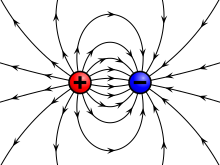An electric field is said to exist at a point if a test charge (unit positive charge) placed at that point experiences an electrical force.
Every charged body exhibits electric field : Theoretically, electric field extends up to infinity but its effect practically dies away very quickly as the distance from the charged body is increased. Therefore, the region where the influence of a charged body can be experienced is very limited and this region or space near the charged body is called electric field.

An electric field cannot be seen. Therefore, to visualize electric field pattern, we draw electric lines of force. Each electric line of force starts from positive charge and ends on the negative charge (as shown in fig.).
As a matter of fact, electric lines of force are imaginary lines drawn in the electric field. Thus in fig. above, the electric line of force is acting from left to right. This is also the direction of the electric field.
➝ ➝
Mathematically we can define electric field E as the force (F) acting per unit test charge (qo)
➝ ➝
i.e., E = F/qo
SI unit of electric field is Newton per Coulomb (N/C), and we can also write the above equation as
➝ ➝
F = qo E
➝
Electric field (E) is a vector Quantity and for positive charge, its direction is
➝
towards the direction of force (F) and for negative charge, its direction is opposite to the direction of force.
Electric Field is also called field intensity, field strength or electric field strength.
Electric field can also be defined as : It is the space around a charge in which the other charged body can experience the force of attraction or repulsion.
courtesy:en.wikipedia.org
Every charged body exhibits electric field : Theoretically, electric field extends up to infinity but its effect practically dies away very quickly as the distance from the charged body is increased. Therefore, the region where the influence of a charged body can be experienced is very limited and this region or space near the charged body is called electric field.

An electric field cannot be seen. Therefore, to visualize electric field pattern, we draw electric lines of force. Each electric line of force starts from positive charge and ends on the negative charge (as shown in fig.).
As a matter of fact, electric lines of force are imaginary lines drawn in the electric field. Thus in fig. above, the electric line of force is acting from left to right. This is also the direction of the electric field.
➝ ➝
Mathematically we can define electric field E as the force (F) acting per unit test charge (qo)
➝ ➝
i.e., E = F/qo
SI unit of electric field is Newton per Coulomb (N/C), and we can also write the above equation as
➝ ➝
F = qo E
➝
Electric field (E) is a vector Quantity and for positive charge, its direction is
➝
towards the direction of force (F) and for negative charge, its direction is opposite to the direction of force.
Electric Field is also called field intensity, field strength or electric field strength.
Electric field can also be defined as : It is the space around a charge in which the other charged body can experience the force of attraction or repulsion.
courtesy:en.wikipedia.org
No comments:
Post a Comment